Timewarp
Use the Timewarp node to slow down, speed up, freeze, or reverse frames in a clip. Timewarps can have a constant or variable speed. In some cases, such as when creating a fit to fill edit on the timeline, a Timewarp is added automatically to a segment.
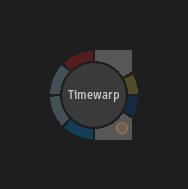
| Access | To access the Timewarp menu, use:
|
| Inputs |
|
| Outputs |
|
Settings
Settings for the Timewarp tool differ between Batch and the Timeline. The following documentation presents the controls for the Batch node and for the Timeline FX, as presented in the Effects environment. It is also possible to modify the Timewarp controls from the Timeline ribbon, in the Timeline tab.

The Timewarp settings in Batch

The Timewarp settings in the Effects environment
Timing Info
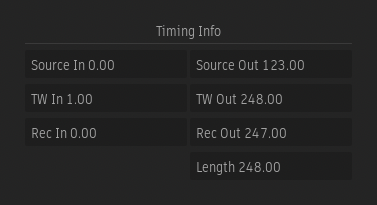
These settings are only available when you access the Timewarp Timeline FX editor, in the Effects environment. They are informational settings only, to give you information about the segment on the Timeline.
Source In
Displays the frame or timecode of the In point of the source segment.
Source Out
Displays the frame or timecode of the Out point of the source segment.
Timewarp In
Displays the frame or timecode of the In point of the Timewarp result.
Timewarp Out
Displays the frame or timecode of the Out point of the Timewarp result.
Record In
Displays the frame number or record timecode of the In point of the segment in the sequence.
Record Out
Displays the frame number or Record timecode of the Out point of the segment in the sequence.
Length
Displays the length of the segment.
Mode
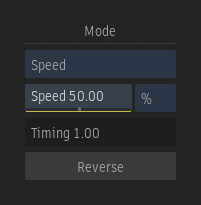
The Mode controls in Batch
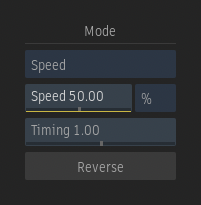
The Mode controls in the Effects environment
Timewarp Mode option
Select a Timewarp mode: Speed, Timing, or Duration (Duration is only available from timeline timewarp). Different settings appear depending on the mode selected. Timewarp modes are mutually exclusive, that is, animation settings are remembered for each mode.
Speed field
Sets the Timewarp speed.
Speed option
Select whether to display the speed as a percentage, or as frames per second.
Speed Timing field
Sets which frame from the source media is shown for the current frame, after the Timewarp is applied.
Reverse button
Click to create reverse timewarp effect; that is, change the speed field value to negative or positive. In Batch, use in conjunction with the Offset field to manually set the desired end of clip.
Timing field
Sets the source frame or timecode value for the current time. You can slip the source Media underneath a Timeline FX Timewarp, without affecting your keyframes, using the Timing field.
Duration field
Sets the duration of the segment in frames or timecode.
Duration Speed field
Sets the speed value corresponding to the duration set in the Duration field.
Strobe
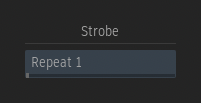
Repeat field
Sets the number of frames or fields to be repeated to create a strobe effect. The strobe effect is applied after the Timewarp effect, so any speed or timing animations are respected when applying the strobe effect.
Anchoring

The Anchoring controls in Batch
Source field
Sets the anchor frame or timecode value of the Timewarp.
Offset field
Sets the amount of offset to apply to the anchor point.
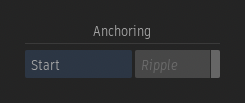
The Anchoring controls in the Effects environment
Anchoring option
Select where to set the anchor frame so that its timing is not affected when modifying a timewarp.
| Select: | To anchor: |
|---|---|
| Start | The In frame value as the value not to change. |
| End | The Out frame value as the value not to change. |
| Start and End | Both the In and Out frame values. In this case, any speed changes affect the length of the media (and the state of the Ripple button has an effect). |
Repeat Mode
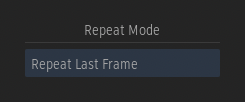
This setting is only available for a Timewarp Timeline FX.
Repeat Mode box
Select how out of range timing values are handled.
| Mode: | Description: |
|---|---|
| Lock to Segment Range | Only use timing values within the range of the segment. The Timing field is displayed in red when reaching a timing value that is impossible to achieve with the current source clip frame range (heads and tails). |
| Repeat Last Frame | Do not clamp or limit the timing values, instead repeat the last frame when reaching the last frame of the segment range. |
| Trim Segment | Trim the segment (based on the selected ripple settings), when any modification to the speed or timing cause the range of source frames to exceed the available frames. |
Frame Interpolation
Frame Interpolation option
Select the frame interpolation used to blend timewarped frames. Different settings appear below depending on the mode selected.
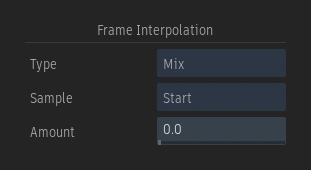
| Mode: | Description: |
|---|---|
| Mix | When mixing frames, you are combining multiple frames together to create one blended frame using an additive mix. Each result frame is a blend of an equal number of frames from both sides of the given frame. |
| Trails | With Trails blending, you have more control than in a simple mix. You can blend the frames before and after a given frame by different amounts. Do this to create a trail that comes before or after any motion in the clip. You can also set the amount of fall-off for the blend so that the trail fades away completely, partially, or not at all. |
| Motion | Motion estimation blends frames with subpixel accuracy, and is well-suited for particularly challenging timewarps. Motion estimation is good for processing slow-motion, constant, or variable speed timewarps of interlaced and progressive material. It is particularly good for material that introduces artefacts or for which you cannot get satisfactory results using Trail or Mix values. |
Machine Learning  |
The inference uses two frames to generate an intermediate frame in-between them. Although any speed value can be set, some values require the creation of more intermediate frames to output the desired result, making the process slower. For example, a Timewarp set to 50% only requires the creation of one frame that is used as the result frame. A Timewarp set to 25% requires the creation of two frames: one used as an intermediate (50%) and a second one used as the result frame (25%). In some cases, up to 10 intermediates may be required to obtain the frame for the desired speed. |

Sample option
Select whether the Timewarp samples the speed or timing curve at the start, in the middle, or at the end of a frame, like for a variable speed Timewarp.

Amount field
Sets the mix value for the Timewarp. Each result frame is a blend of an equal number of frames from both sides of the given frame.
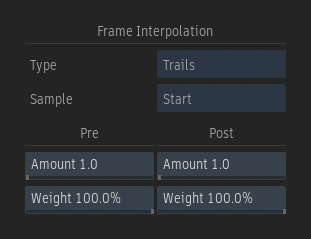
Pre Amount field
Sets the value to mix the frames that precede the current frame with the current frame.
Pre Weight field
Sets the fall-off value for the pretrail. When the value is 0%, the image in the current frame is at 100% intensity and the first image in the trail is at 0% intensity. When the value is at 100%, there is no fall-off.
Post Amount field
Sets the value to mix the frames that follow the current frame with the current frame.
Post Weight field
Sets the fall-off value for the posttrail. When the value is 0%, the image in the current frame is at 100% intensity and the first image in the trail is at 0% intensity. When the value is at 100%, there is no fall-off. Editable.

Motion Analysis Quality option
Select the level of motion analysis accuracy and rendering speed. Select Use Full Resolution to render the images at the current resolution. In Batch or Batch FX, this setting is unavailable if an external input is attached to the node's forward vector or backward vector tabs.
Using the Full Resolution augments the analysis time, but provides higher quality results.
Motion Blur Active
Enable to apply a motion blur to the selected clip.
Samples field
Sets the number of frames to sample when creating the Timewarp. The samples include the current frame, and an equal distribution of past and future frames.
Shutter field
Sets the number of frames for which the shutter stays open. For example, when the shutter value is set to 3, every third frame is as a sample.
Reference Active
Enable to apply the Timewarp only to objects that do not have the same relative motion as the selected pixel. When enabled, you can edit values in the X and Y fields.
Reference Colour
Sets the colour of the crosshair that marks the reference point inside the Player / Viewport.
Reference X field
Sets the horizontal position of the pixel to use as a reference point at the selected frame.
Reference Y field
Sets the vertical position of the pixel to use as a reference point at the selected frame.
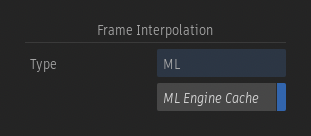
Rendering Platform option 
Select whether the Machine Learning inference runs on the CPU or GPU.
On Rocky Linux, an inference can be run using either the CPU or GPU. On macOS, the inference is always run on the CPU. Running the inference is faster on the GPU, but larger frames that cannot be rendered using it can be rendered using the CPU.
ML Engine Cache 
Enable to use NVIDIA's TensorRT cache.
This option is disabled by default as the generation of the tensorRT engine can take several minutes. Because the cache requires a new tensorRT engine for each combination of ML inference model, GPU, and image size, a new engine is generated each time a new model is applied on a new combination. Each engine is stored in a cache in /opt/Autodesk/cache/tensorgraph/models and is used the next time the same ML inference model, GPU, and image size combination is required, making it much faster to use the node.
Bit Depth option 
Select whether the model is run in 16-bit fp or 32-bit fp on the GPU platform.
This option is only available on Rocky Linux.
Selecting 16-bit fp offers the following advantages:
- It allows running a model on higher resolution images, since running in 16-bit fp requires less memory.
- It provides better performance.
Rendering Mode

Rendering Mode option
Select the render mode between Progressive, Interlaced, or Automatic (using the scan format of the source).
Field Interpolation option
Select an interpolation mode (available if Interlaced or Automatic is selected as the rendering mode box). Interpolation helps remove field jitter artefacts that are produced when a reversal of fields occurs during the timewarp.
| Select: | To: |
|---|---|
| No Interpolation | Use no field interpolation. |
| Half Interpolation | Interpolate only on displaced fields. |
| Full Interpolation | Interpolate on all fields. Note that this option has the least aliasing, but you may notice some softening of the image due to the blending of the fields. |
| Shift Up | Shift the image up by a single line. This may help reduce artefacts that appear in reverse timewarps of 100%. |
| Shift Down | Shift the image down by a single line. This may help reduce artefacts that appear in reverse timewarps of 100%. |
Start Frame
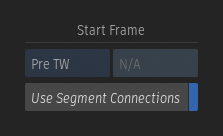
These settings are only available for a Timewarp Timeline FX.
Start Frame option
Select how to set the start frame of the timeline segment.
| Select: | To: |
|---|---|
| Pre TW | Return the start frame of the segment as the Start Frame at the beginning of the segment and then increment by one for other frames. |
| Post TW | Return the start frame of the frame seen with the Timewarp FX. |
| Custom | Manually set the start frame at the beginning of the segment. When the Timewarp Timeline FX is set to Custom mode using the Change Start Frame function modifies the Timewarp FX instead of the source. For content with negative Timewarp FX, it is recommended to use the Custom mode. |
Custom Start Frame field
Sets the custom Start Frame value.
Use Segment Connections
Enable to apply the changes made to the Start Frame to all connected segments.
